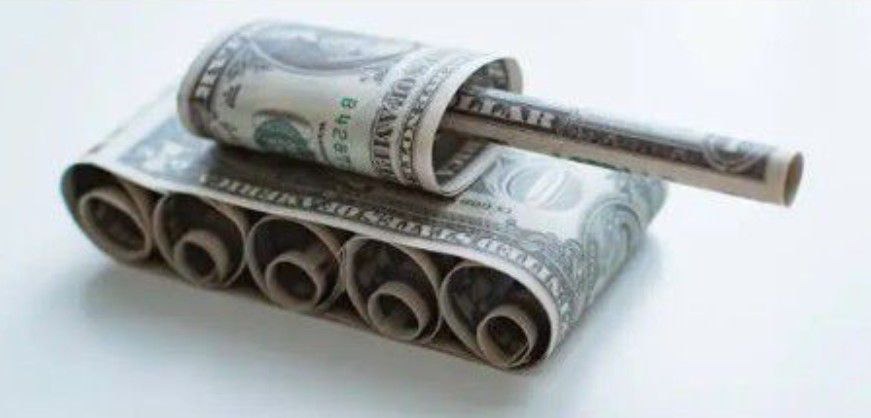Arms, Dollars, and Sanctions: The Triad of U.S. Global Destabilization

In the chessboard of global politics, the United States has mastered a three-piece strategy: arms, dollars, and sanctions. These are not mere instruments of diplomacy; they are powerful tools used to redraw borders, control economies, and influence political outcomes across the globe.
At the heart of this strategy lies a dangerous game: the creation of dual-neighboring adversaries, where one is punished and the other is pampered, all for America's strategic gain. This is not about peace; it’s about perpetual instability, controlled conflict, and economic exploitation.
“In the theater of global power, America is not the director of peace, it is the shadow playwright of conflict.” ~ Adarsh Singh
The Three-Tool Doctrine: Arms, Dollars, Sanctions
Arms ~ Supplied to create military dependence, escalate conflicts, and fuel war economies.
Dollars ~ Given as aid, loans, or investments with strings attached, ensuring control over policy and resources.
Sanctions ~ Imposed to economically cripple nations that resist U.S. dominance or tilt toward rivals like Russia or China.
This combination allows the U.S. to play both sides, maintain leverage, and ensure that conflicts never truly resolve, because peace doesn’t pay, but war does.
Global Footprints of Destabilization
Let us explore countries where this strategy has been implemented, openly or covertly, leading to long-term regional instability and suffering.
🇮🇶 Iraq vs Iran
Arms to Iraq (1980s) during the Iran-Iraq war.
Sanctions on Iran post-1979 revolution.
Eventually, invasion of Iraq (2003) on fabricated WMD claims, followed by chaos, sectarian violence, and rise of ISIS.
“When oil flows beneath, peace is never allowed to rise above.” ~ Adarsh Singh
🇮🇳 India vs Pakistan
During the Cold War, Pakistan received military aid and dollars as a U.S. ally.
India faced sanctions after nuclear tests in 1974 and 1998.
Even in recent decades, the U.S. has played the balancing act, arming Pakistan while courting India for counter-China strategy.
🇷🇺 Russia vs Ukraine
U.S. supported Ukrainian regime change in 2014, prompting Russia to annex Crimea.
Sanctions on Russia intensified post-2022.
Billions of dollars in arms and aid to Ukraine, leading to an extended proxy war.
🇻🇪 Venezuela vs Colombia
Venezuela sanctioned, with its assets frozen and economy collapsed.
Colombia militarized with U.S. aid, becoming a close ally and regional power.
Result: destabilization of northern Latin America, mass migration, and poverty.
🇸🇾 Syria vs U.S.-backed Rebel Groups
U.S. armed various rebel factions in Syria, leading to civil war.
Sanctions on Assad regime worsened the humanitarian crisis.
Proxy war zone involving Russia, Iran, and the U.S., devastating an ancient nation.
🇾🇪 Yemen vs Saudi Coalition
U.S. backs Saudi Arabia with arms and intelligence in its war on Yemen.
Yemen’s Houthis are under U.S. sanctions and airstrikes.
A catastrophic humanitarian crisis with little global accountability.
🇦🇫 Afghanistan vs Taliban
Armed Taliban during the Soviet invasion.
Fought the same Taliban post-2001.
20 years of war, billions spent, and a chaotic U.S. withdrawal left the country in ruin.
“Every time the U.S. leaves, it leaves behind a graveyard of hope.” ~ Adarsh Singh
🇰🇵 North Korea vs South Korea
South Korea armed and financed, with U.S. troops on ground.
North Korea sanctioned and isolated.
Permanent division maintained as a tool of pressure in East Asia.
🇸🇩 Sudan vs South Sudan
U.S. promoted South Sudan’s independence, backed with aid and arms.
Sanctions on Sudan’s government.
Result: decades of civil war in both nations with immense human loss.
The Bucket Strategy: Creating Enemies and Allies
The U.S. doesn’t just pick one side, it engineers long-term hostility between neighboring nations. One is dollar-fed, the other sanction-strangled. This creates:
Asymmetric development
Security dilemmas
Dependence on the U.S. for arms or mediation
This policy keeps the U.S. at the center of every conflict and ensures global subservience to its interests.
“If two neighbors are fighting, check who sold them the weapons. That’s where true responsibility lies.” ~ Adarsh Singh
Economic Colonialism in Modern Form
Beyond conflicts, this triad has enabled a new form of colonialism:
IMF and World Bank loans with U.S. influence.
Arms trade controlled by American manufacturers.
Sanctions used to strangle resource-rich countries not aligned with U.S. policy.
This is not freedom, it’s neo-imperialism wearing a diplomatic mask.
The Irony of Peacekeepers
While America claims to be a promoter of democracy and peace, its interventions have:
Toppled democracies (Chile, Iran, Libya)
Created refugee crises (Syria, Afghanistan, Iraq)
Supported dictatorships (Saudi Arabia, Egypt)
“Peace doesn’t come from who shouts it loudest in the UN, it comes from those who never sell it for profit.” ~ Adarsh Singh
A World Awakening to Reality
The world is slowly awakening to this pattern of manufactured instability. With the rise of multipolarity, regional powers, and alternative alliances like BRICS, the U.S. model of conflict profiteering is being questioned.
“Let it be known in history: the real destroyer of peace was not the rebel, but the empire pretending to be the referee.” ~ Adarsh Singh
Mon Jun 23, 2025
